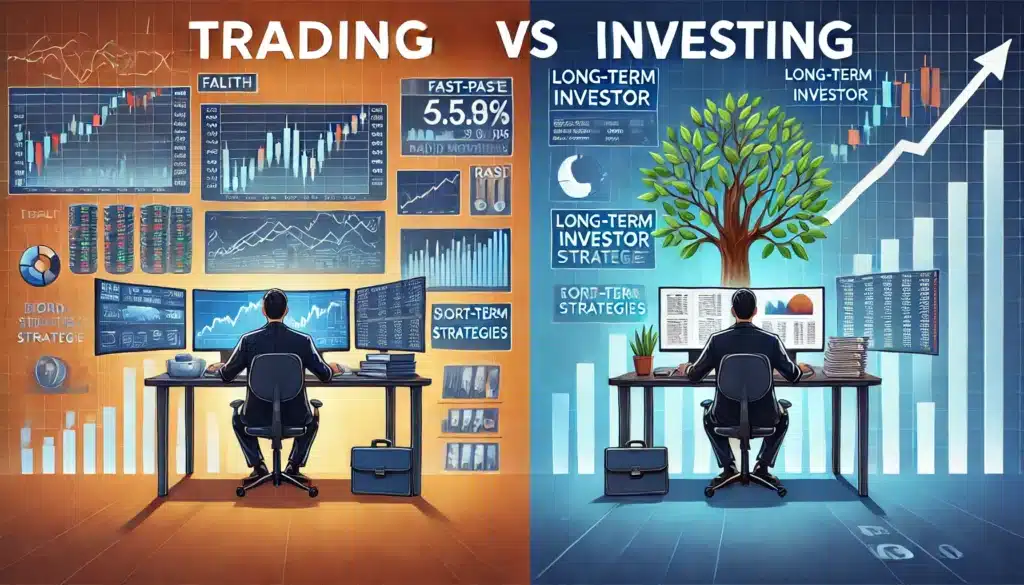Trading vs Investing
Trading vs Investing
Navigating the Financial Markets

In the world of finance, two terms often come up in discussions about growing wealth: trading and investing. While both involve participating in financial markets, they represent distinct approaches with different goals, strategies, and time horizons. This comprehensive guide will delve into the key differences between trading and investing, helping you understand which approach might be best suited for your financial goals and risk tolerance.
Understanding the Basics
What is Trading?
Trading is the practice of buying and selling financial instruments, such as stocks, bonds, commodities, or cryptocurrencies, with the primary goal of generating short-term profits. Traders aim to capitalize on market fluctuations and price movements, often holding positions for brief periods ranging from seconds to months.
What is Investing?
Investing, on the other hand, involves allocating funds into financial assets with the expectation of generating returns over a longer period. Investors typically hold onto their assets for years or even decades, focusing on the fundamental value and growth potential of their investments rather than short-term price movements.
Key Differences Between Trading and Investing
1. Time Horizon
One of the most significant differences between trading and investing lies in the time horizon.
Trading Time Horizon
- Short-term focus
- Positions held for seconds, minutes, hours, days, or weeks
- Rarely exceeds a few months
Investing Time Horizon
- Long-term perspective
- Positions held for years or decades
- Focus on riding out short-term market fluctuations
2. Goals and Objectives
The goals of traders and investors differ substantially, influencing their strategies and decision-making processes.
Trading Goals
- Generate quick profits from short-term price movements
- Capitalize on market inefficiencies and volatility
- Achieve a high number of winning trades
Investing Goals
- Build long-term wealth through capital appreciation and income
- Benefit from compound interest over time
- Achieve financial objectives like retirement or funding education
3. Risk and Volatility
The approach to risk and market volatility varies significantly between trading and investing.
Trading Risk Profile
- Higher risk due to frequent transactions and leverage
- Embraces volatility as an opportunity for profit
- Requires active risk management and stop-loss strategies
Investing Risk Profile
- Generally lower risk, especially with diversified portfolios
- Views volatility as a natural part of market cycles
- Relies on time and compound interest to mitigate short-term risks
Strategies and Approaches
Trading Strategies
Traders employ various strategies to capitalize on market movements:
- Day Trading: Opening and closing positions within a single trading day
- Swing Trading: Holding positions for several days to weeks
- Scalping: Making numerous trades to profit from small price changes
- Momentum Trading: Buying rising assets and selling falling ones
- Technical Analysis: Using charts and indicators to predict price movements
Investing Strategies
Investors typically follow more passive strategies focused on long-term growth:
- Buy and Hold: Purchasing assets and holding them for extended periods
- Dollar-Cost Averaging: Regularly investing fixed amounts regardless of market conditions
- Value Investing: Seeking undervalued assets with strong growth potential
- Growth Investing: Focusing on companies with high growth prospects
- Dividend Investing: Investing in stocks that provide regular income through dividends
Tools and Analysis
Trading Tools
- Real-time charts and technical indicators
- News feeds and economic calendars
- Trading platforms with quick execution capabilities
- Risk management tools like stop-loss orders
Investing Tools
- Fundamental analysis reports
- Company financial statements
- Economic and industry research
- Portfolio management and asset allocation software
Pros and Cons
Trading Pros and Cons
Pros of Trading
- Potential for quick profits
- Ability to profit in both rising and falling markets
- Excitement and active engagement with markets
- Opportunity to develop valuable market insights
Cons of Trading
- Higher risk of significant losses
- Time-intensive and potentially stressful
- Requires constant monitoring and analysis
- Higher transaction costs and potential tax implications
Investing Pros and Cons
Pros of Investing
- Potential for steady, long-term wealth accumulation
- Less time-intensive than active trading
- Benefits from compound interest over time
- Generally lower risk with proper diversification
Cons of Investing
- Slower pace of returns
- Requires patience and discipline
- May miss out on short-term profit opportunities
- Vulnerable to long-term market downturns
Which Approach is Right for You?
Choosing between trading and investing depends on various factors:
- Financial Goals: Short-term gains vs. long-term wealth building
- Risk Tolerance: Ability to handle volatility and potential losses
- Time Commitment: Available time for market analysis and monitoring
- Knowledge and Experience: Understanding of financial markets and instruments
- Capital Available: Initial investment and ongoing funding capabilities
Conclusion: Finding the Right Balance
While trading and investing represent different approaches to participating in financial markets, they are not mutually exclusive. Many successful market participants incorporate elements of both strategies in their overall financial plan.
For beginners, starting with a long-term investing approach can provide a solid foundation for understanding market dynamics and building wealth steadily. As you gain experience and knowledge, you may choose to allocate a portion of your portfolio to more active trading strategies.
Ultimately, the key to success in both trading and investing lies in education, discipline, and a clear understanding of your financial goals and risk tolerance. Whether you choose to trade, invest, or combine both approaches, remember that consistent research, analysis, and adaptation to market conditions are crucial for long-term financial success.
By understanding the distinctions between trading and investing, you can make informed decisions about how to approach the financial markets and work towards achieving your unique financial objectives.
Check out our article on:
- Introduction to Options Trading
- Mastering Butterfly Spreads
- The Power of Diagonal Spreads
- The Power of Iron Condors
- The Power of Vertical Credit Spreads
Elevate Your Trading Game
Ready to take your options trading to new heights? Whether you’re a day trader, swing trader, or busy professional, we have you covered. Join our exclusive community of traders and gain access to our comprehensive educational resources, live trading sessions, and expert analysis. We’ll guide you through the intricacies of debit spreads and other advanced options strategies, helping you achieve your financial goals. Don’t miss out on this opportunity to become a more confident and profitable trader. Sign up today!
Below are the links:
To your success,

Billy Ribeiro is a renowned name in the world of financial trading, particularly for his exceptional skills in options day trading and swing trading. His unique ability to interpret price action has catapulted him to global fame, earning him the recognition of being one of the finest price action readers worldwide. His deep comprehension of the nuances of the market, coupled with his unparalleled trading acumen, are widely regarded as second to none.
Connect with us:





